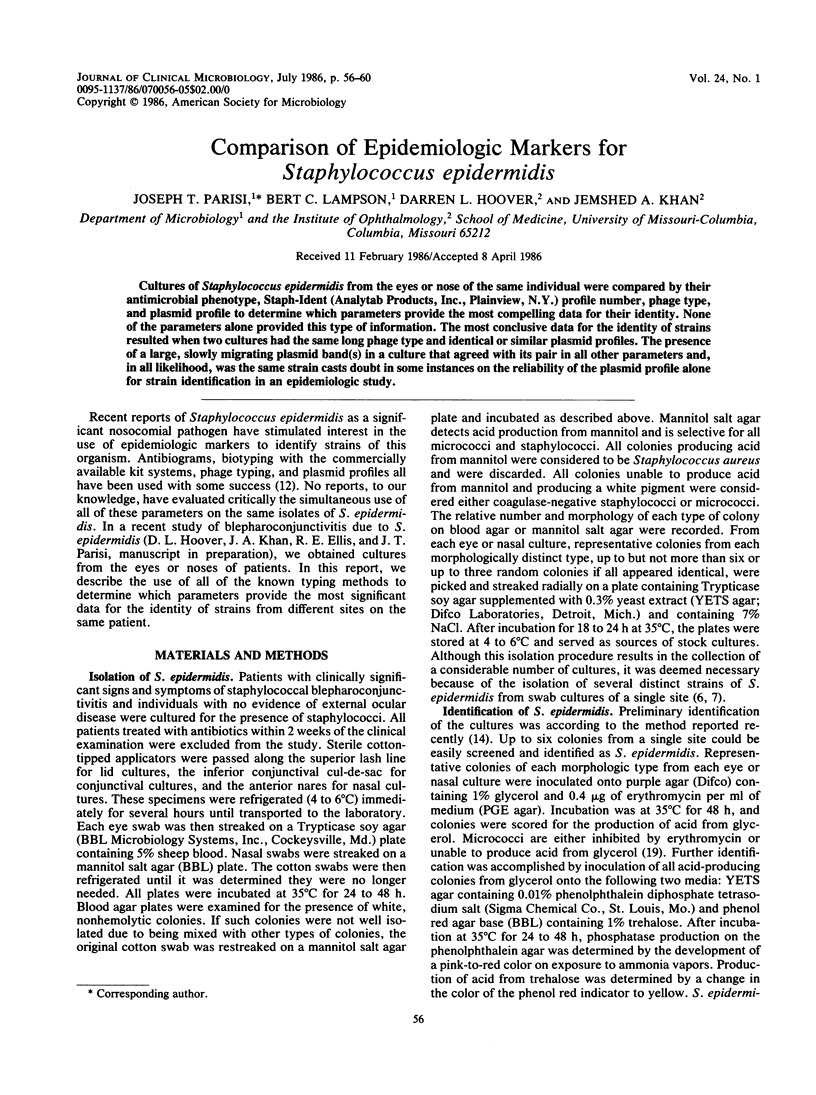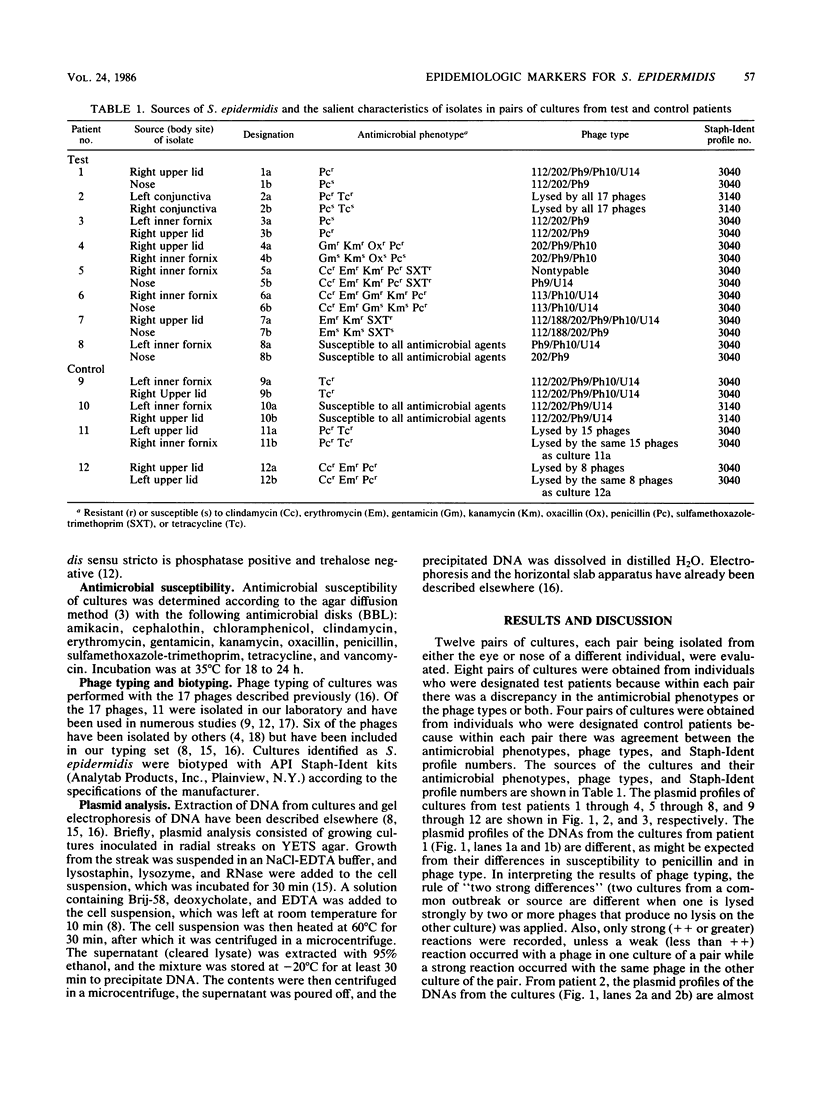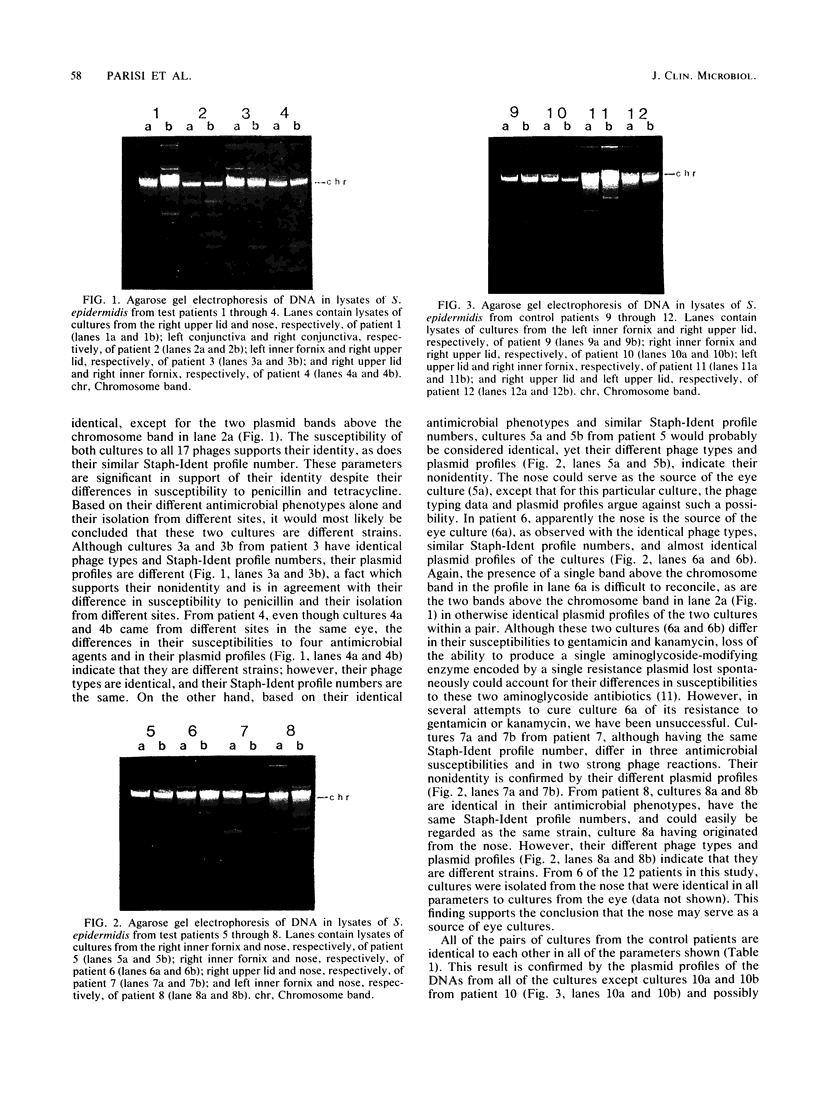Abstract
Cultures of Staphylococcus epidermidis from the eyes or nose of the same individual were compared by their antimicrobial phenotype, Staph-Ident (Analytab Products, Inc., Plainview, N.Y.) profile number, phage type, and plasmid profile to determine which parameters provide the most compelling data for their identity. None of the parameters alone provided this type of information. The most conclusive data for the identity of strains resulted when two cultures had the same long phage type and identical or similar plasmid profiles. The presence of a large, slowly migrating plasmid band(s) in a culture that agreed with its pair in all other parameters and, in all likelihood, was the same strain casts doubt in some instances on the reliability of the plasmid profile alone for strain identification in an epidemiologic study.
Full text
PDF




Images in this article
Selected References
These references are in PubMed. This may not be the complete list of references from this article.
- Archer G. L., Karchmer A. W., Vishniavsky N., Johnston J. L. Plasmid-pattern analysis for the differentiation of infecting from noninfecting Staphylococcus epidermidis. J Infect Dis. 1984 Jun;149(6):913–920. doi: 10.1093/infdis/149.6.913. [DOI] [PubMed] [Google Scholar]
- Archer G. L., Vishniavsky N., Stiver H. G. Plasmid pattern analysis of Staphylococcal epidermidis isolates from patients with prosthetic valve endocarditis. Infect Immun. 1982 Feb;35(2):627–632. doi: 10.1128/iai.35.2.627-632.1982. [DOI] [PMC free article] [PubMed] [Google Scholar]
- Blouse L. E., Lathrop G. D., Kolonel L. N., Brockett R. M. Epidemiologic features and phage types associated with nosocomial infections caused by Staphylococcus epidermidis. Zentralbl Bakteriol Orig A. 1978 Jul;241(1):119–135. [PubMed] [Google Scholar]
- Christensen G. D., Parisi J. T., Bisno A. L., Simpson W. A., Beachey E. H. Characterization of clinically significant strains of coagulase-negative staphylococci. J Clin Microbiol. 1983 Aug;18(2):258–269. doi: 10.1128/jcm.18.2.258-269.1983. [DOI] [PMC free article] [PubMed] [Google Scholar]
- Dean B. A., Williams R. E., Hall F., Corse J. Phage typing of coagulase-negative staphylococci and micrococci. J Hyg (Lond) 1973 Jun;71(2):261–270. doi: 10.1017/s0022172400022737. [DOI] [PMC free article] [PubMed] [Google Scholar]
- Heczko P. B., Klein A., Kasprowicz A., Pulverer G. Use of a phage set for the ecological typing of coagulase-negative staphylococci. Zentralbl Bakteriol Orig A. 1978 Jul;241(1):157–164. [PubMed] [Google Scholar]
- Hutton J. P., Hamory B. H., Parisi J. T., Strausbaugh L. J. Staphylococcus epidermidis arthritis following catheter-induced bacteremia in a neutropenic patient. Diagn Microbiol Infect Dis. 1985 Mar;3(2):119–124. doi: 10.1016/0732-8893(85)90020-3. [DOI] [PubMed] [Google Scholar]
- Mickelsen P. A., Plorde J. J., Gordon K. P., Hargiss C., McClure J., Schoenknecht F. D., Condie F., Tenover F. C., Tompkins L. S. Instability of antibiotic resistance in a strain of Staphylococcus epidermidis isolated from an outbreak of prosthetic valve endocarditis. J Infect Dis. 1985 Jul;152(1):50–58. doi: 10.1093/infdis/152.1.50. [DOI] [PubMed] [Google Scholar]
- Neu H. C. Changing patterns of hospital infections: implications for therapy. Changing mechanisms of bacterial resistance. Am J Med. 1984 Jul 31;77(1B):11–23. [PubMed] [Google Scholar]
- Parisi J. T. Coagulase-negative staphylococci and the epidemiological typing of Staphylococcus epidermidis. Microbiol Rev. 1985 Jun;49(2):126–139. doi: 10.1128/mr.49.2.126-139.1985. [DOI] [PMC free article] [PubMed] [Google Scholar]
- Parisi J. T., Hamory B. H. Simplified method for the isolation, identification, and characterization of Staphylococcus epidermidis in epidemiologic studies. Diagn Microbiol Infect Dis. 1986 Jan;4(1):29–35. doi: 10.1016/0732-8893(86)90053-2. [DOI] [PubMed] [Google Scholar]
- Parisi J. T., Hecht D. W. Plasmid profiles in epidemiologic studies of infections by Staphylococcus epidermidis. J Infect Dis. 1980 May;141(5):637–643. doi: 10.1093/infdis/141.5.637. [DOI] [PubMed] [Google Scholar]
- Parisi J. T., Robbins J., Lampson B. C., Hecht D. W. Characterization of a macrolide, lincosamide, and streptogramin resistance plasmid in Staphylococcus epidermidis. J Bacteriol. 1981 Nov;148(2):559–564. doi: 10.1128/jb.148.2.559-564.1981. [DOI] [PMC free article] [PubMed] [Google Scholar]
- Parisi J. T., Talbot H. W., Skahan J. M. Development of a phage typing set for Staphylococcus epidermidis in the United States. Zentralbl Bakteriol Orig A. 1978 Jul;241(1):60–67. [PubMed] [Google Scholar]
- Pulverer G., Pillich J., Klein A. New bacteriophages of Staphylococcus epidermidis. J Infect Dis. 1975 Nov;132(5):524–531. doi: 10.1093/infdis/132.5.524. [DOI] [PubMed] [Google Scholar]
- Schleifer K. H., Kloos W. E. A simple test system for the separation of staphylococci from micrococci. J Clin Microbiol. 1975 Mar;1(3):337–338. doi: 10.1128/jcm.1.3.337-338.1975. [DOI] [PMC free article] [PubMed] [Google Scholar]





